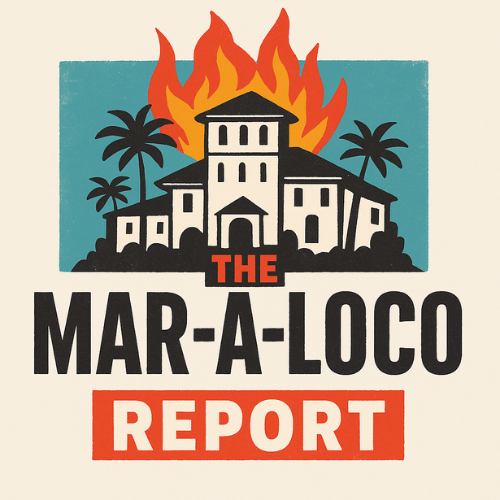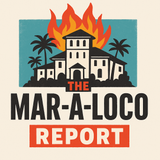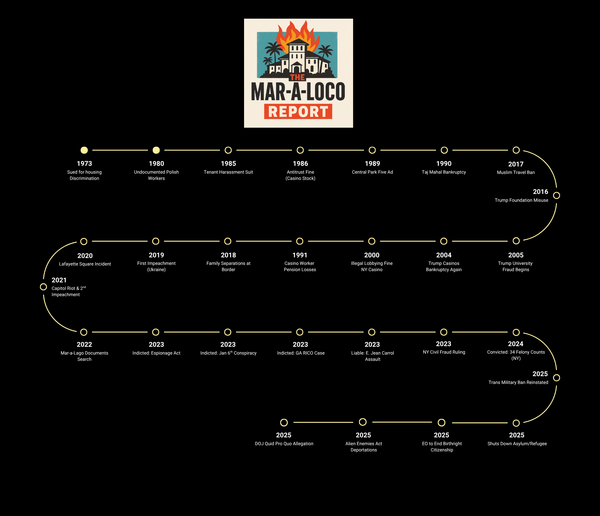Trump’s “Big Beautiful Bill” vs. Project 2025: What’s Really Going On?
Trump claims he has “nothing to do with Project 2025,” but his 1,200-page bill says otherwise. From slashing food aid to gutting the EPA, the “Big Beautiful Bill” mirrors the far-right playbook. Here’s how—and why it matters.
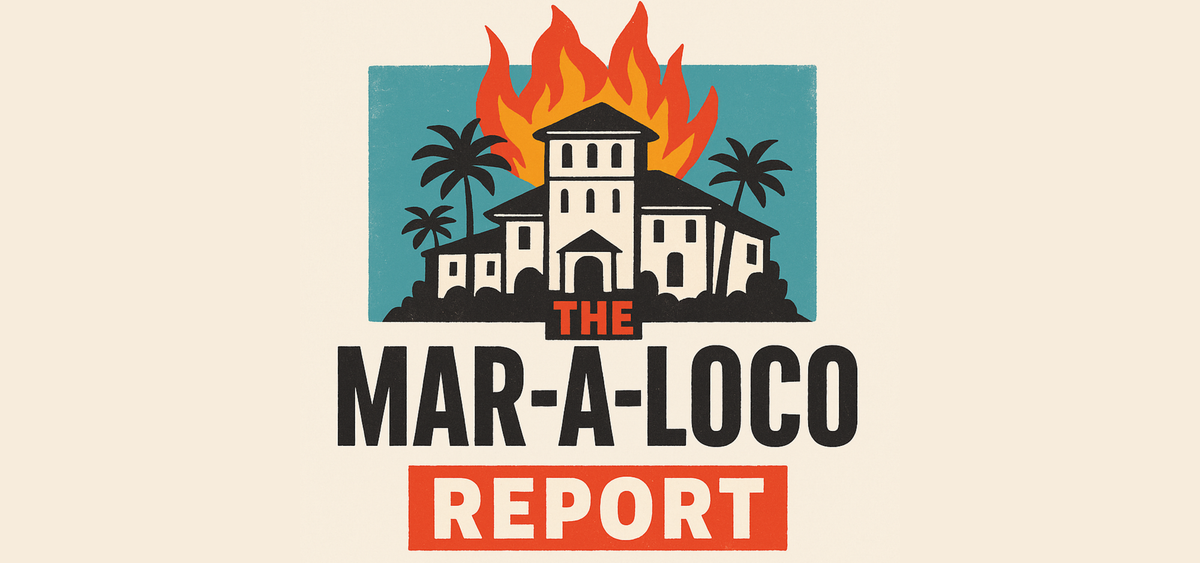
👋 Hey y’all, my name is Cole, and welcome to The Mar-a-Loco Report.
This blog is where I break down political chaos—week by week, bill by bill. I don’t do hot takes. I do receipts, policy, and straight facts with a little opinion sprinkled in. Because when people in power lie, it’s up to us to call it out—with evidence.
This week, we’re diving into Trump’s newly passed “Big Beautiful Bill”—a 1,200-page legislative beast packed with structural changes to the federal government.
Trump campaigned on having “nothing to do with Project 2025”—claiming he’s “never read it.” But since this bill dropped, he’s gone silent. Meanwhile, the legislation reads like he photocopied it.
What Is Project 2025?
Project 2025 is not just a policy wishlist. It’s a 900+ page strategic playbook authored by the Heritage Foundation and more than 50 far-right organizations. It lays out, in detail, how to reshape the federal government under the next Republican president. The goals are sweeping:
- Fire thousands of career civil servants and replace them with loyalists.
- Eliminate or defund key regulatory and social programs.
- Shift power away from Congress and the courts toward the executive.
- Weaken protections for the environment, labor, healthcare, and the financial system.
It’s a roadmap for consolidating power and unraveling decades of bipartisan governance norms.
So What’s in the “Big Beautiful Bill”?
The overlap with Project 2025 isn’t superficial. It’s structural. Let’s dig into the sections that matter most:
🏛 Executive Power & Federal Control
Project 2025 (pp. 43–45):
Project 2025 proposes transforming the federal bureaucracy into a tool of direct presidential control. It recommends reviving "Schedule F," a Trump-era order allowing the president to reclassify and fire thousands of federal workers, and removing the independence of agencies.
Big Beautiful Bill:
- Sec. 30051 – Requires agencies to meet strict cost-benefit tests before issuing rules, effectively paralyzing regulatory action unless it passes executive approval.
- Sec. 30061 – Prevents the Secretary of Education from issuing new regulations at all.
Why it matters: These provisions don’t just streamline bureaucracy—they dismantle it. They hand the executive branch sole authority over agency decisions, stripping experts of power and turning every policy choice into a political loyalty test. When regulatory agencies lose independence, industries can operate with little oversight, and public interests (like clean air, labor rights, and consumer safety) take a back seat to political goals.
🌾 Environmental Deregulation
Project 2025 (pp. 417–418):
Calls for eliminating the EPA’s power to regulate emissions, repealing climate protections, and opening federal lands to fossil fuel development. Frames environmental oversight as economically harmful and ideologically driven.
Big Beautiful Bill:
- Sec. 42108 – Repeals key sections of the Clean Air Act.
- Sec. 42301 – Eliminates EPA vehicle emissions standards.
- Sec. 80307–80309 – Cancels funding for national park preservation, ecosystem restoration, and climate adaptation.
- Sec. 42117 – Ends environmental justice block grants.
Why it matters: Climate change is accelerating. These rollbacks gut our ability to respond. By removing emissions rules and defunding conservation programs, the bill opens the door for increased pollution, weaker public health protections, and the acceleration of environmental collapse. It also disproportionately harms low-income and frontline communities—exactly the groups environmental justice policies aim to protect.
🥛 Food Assistance & Work Requirements
Project 2025 (pp. 299–301, 327–328):
Wants to make food aid contingent on work, restrict SNAP eligibility, and eliminate flexible state options for assistance. It portrays food insecurity as a moral failure rather than a structural issue.
Big Beautiful Bill:
- Sec. 10008 – Expands SNAP work requirements to more adults.
- Sec. 10011 – Cuts funding for education and obesity prevention tied to food access.
- Sec. 44141 – Mandates Medicaid recipients meet work requirements.
Why it matters: These changes don’t just affect "lazy freeloaders"—they hurt working families, caregivers, people with disabilities, and low-wage workers. When Arkansas imposed similar SNAP rules, 23,000 people lost food aid in 5 months. Nationally, 800,000+ could be impacted. These aren’t just numbers—they’re meals lost, health risks increased, and lives destabilized. And all while $1.5 trillion in tax cuts go to the wealthy.
📆 Undermining Oversight & Accountability
Project 2025 (pp. 838–840):
Seeks to dismantle oversight institutions like the Consumer Financial Protection Bureau (CFPB) and weaken government regulation of finance and industry. Frames them as partisan and illegitimate.
Big Beautiful Bill:
- Sec. 50003 – Slashes CFPB enforcement capabilities.
- Sec. 50002 – Undermines oversight boards like PCAOB, which police Wall Street.
- Sec. 80121(h) – Blocks courts from reviewing federal permit decisions.
Why it matters: Without oversight, there’s no accountability. These provisions neuter the institutions that protect consumers, investors, and the environment. Stripping courts of authority removes a vital check on executive overreach and corporate abuse. The result? A deregulated, unchecked, and unaccountable government.
🤬 Targeting Judicial Independence and States’ Rights
Project 2025 (pp. 50–51):
Argues courts and states stand in the way of a bold conservative presidency and proposes reducing their ability to interfere.
Big Beautiful Bill:
- Sec. 44001 – Bans state/local governments from regulating artificial intelligence for a decade.
- Sec. 80121(h) – Prevents courts from ruling on certain environmental approvals.
Why it matters: This isn’t just policy. It’s a direct challenge to federalism and judicial review, which are core American principles. Blocking courts and states from acting independently allows for unchecked federal control over emerging technologies, environmental exploitation, and industry growth, even against the public interest.
Final Thought: If He’s Lying About This…
Trump insists:
“I have nothing to do with Project 2025.”
“I’ve never read it.”
“I don’t know who’s behind it.”
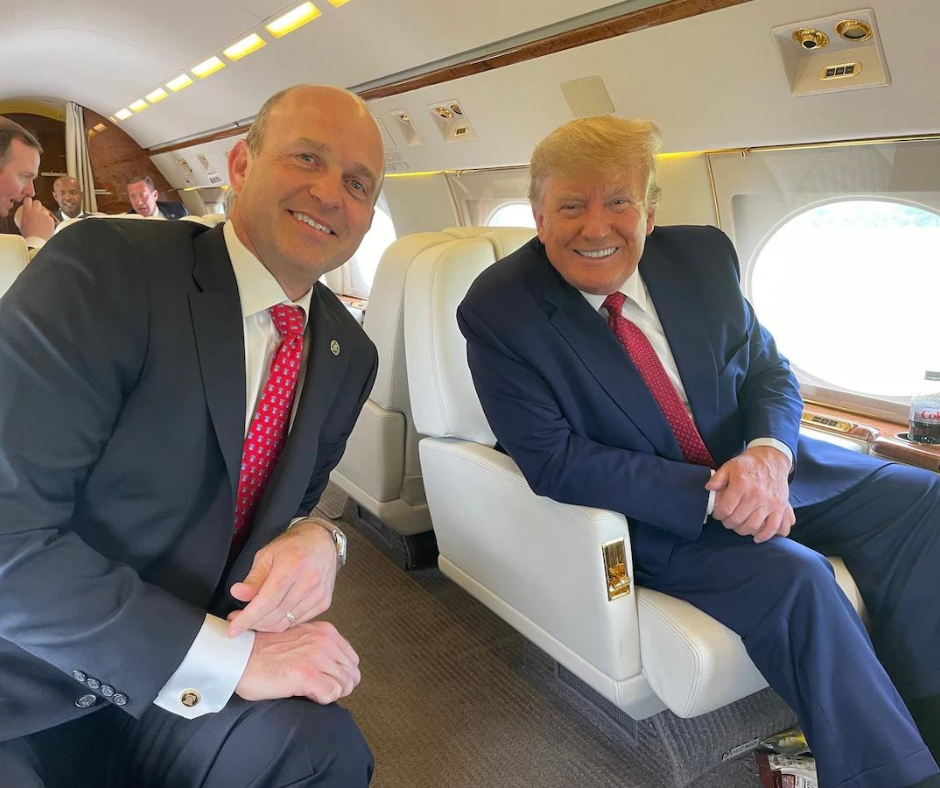
Except, he was photographed flying private with Kevin Roberts, Heritage Foundation president and lead author of the Project 2025 playbook.
You can watch him deny it here:
Thanks for reading. If you’re tired of headlines and spin, and want actual breakdowns of what’s happening behind closed doors, you’re in the right place.
Subscribe. Share. Stay loud.
Cole
Founder, The Mar-a-Loco Report
